地下水枯竭区地下水干旱危害评估:对大规模干旱预警系统的建议
IF 5
1区 地球科学
Q2 ENVIRONMENTAL SCIENCES
引用次数: 0
摘要
在地下水枯竭(GWD)地区,地下水储存(GWS)的负趋势对地下水干旱探测来说是个问题,因为它们掩盖了气候引起的干旱信号。由于在任何大规模干旱预警系统(LDEWS)中尚未考虑到这一点,我们使用全球水文模型WaterGAP 2.2e中的GWS,首次在全球尺度上研究如何在GWD地区最好地量化地下水干旱。我们分析了两种方法:(a)月度GWS时间序列的线性趋势分析和(b)假设没有人类用水计算的归化GWS分析。我们发现线性趋势不适合全球尺度的地下水干旱监测和预测,因为即使与明显的线性趋势有很小的偏差,也会导致对干旱危害的系统性高估和低估。相比之下,归化GWS的指标可以识别气候引起的GWS异常。我们建议在LDEWS中提供地下水干旱的规模、持续时间和严重程度的指标,这些指标是基于模型派生的GWS的每月时间序列,模拟有(“蚂蚁”变量)和无水(“nat”变量)。在GWD和非GWD地区,“nat”变异体提供了气候引起的干旱发生的信息。在GWD区域,它们指定了气候引起的地下水补给变化加剧或缓解GWS负趋势的时期,而“蚂蚁”变体的信息价值非常有限。在非gwd地区,通过对“nat”和“ant”变异的联合分析,可以得知人类活动是否加剧或减轻了气候引起的干旱。本文章由计算机程序翻译,如有差异,请以英文原文为准。
Assessing Groundwater Drought Hazard in Groundwater Depletion Regions: Recommendations for Large-Scale Drought Early Warning Systems
In groundwater depletion (GWD) regions, negative trends in groundwater storage (GWS) are problematic for groundwater drought detection, since they mask climate-induced drought signals. As this is not yet considered in any large-scale drought early warning system (LDEWS), we used GWS from the global hydrological model WaterGAP 2.2e to investigate, for the first time at the global scale, how groundwater drought can best be quantified in GWD regions. We analyzed two methods: (a) Linear detrending of monthly GWS time series and (b) analysis of naturalized GWS computed by assuming no human water use. We found that linear detrending is unsuitable for global-scale groundwater drought monitoring and forecasting as even small deviations from a pronounced linear trend can lead to a systematic over- and underestimation of the drought hazard. In contrast, indicators from naturalized GWS can identify climate-induced GWS anomalies. We recommend to provide, in LDEWS, indicators of the magnitude, duration, and severity of groundwater drought that are based on monthly time series of model-derived GWS simulated with (“ant” variant) and without water use (“nat” variant). In both GWD and non-GWD regions, the “nat” variants inform about the occurrence of climate-induced droughts. In GWD regions, they specify periods in which the negative GWS trend is either exacerbated or alleviated by climate-induced variations of groundwater recharge, while “ant” variants are of very limited informative value. In non-GWD regions, the joint analysis of “nat” and “ant” variants informs whether a climate-induced drought is aggravated or alleviated due to human activities.
求助全文
通过发布文献求助,成功后即可免费获取论文全文。
去求助
来源期刊

Water Resources Research
环境科学-湖沼学
CiteScore
8.80
自引率
13.00%
发文量
599
审稿时长
3.5 months
期刊介绍:
Water Resources Research (WRR) is an interdisciplinary journal that focuses on hydrology and water resources. It publishes original research in the natural and social sciences of water. It emphasizes the role of water in the Earth system, including physical, chemical, biological, and ecological processes in water resources research and management, including social, policy, and public health implications. It encompasses observational, experimental, theoretical, analytical, numerical, and data-driven approaches that advance the science of water and its management. Submissions are evaluated for their novelty, accuracy, significance, and broader implications of the findings.
 求助内容:
求助内容: 应助结果提醒方式:
应助结果提醒方式:


